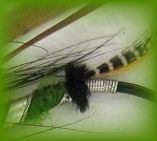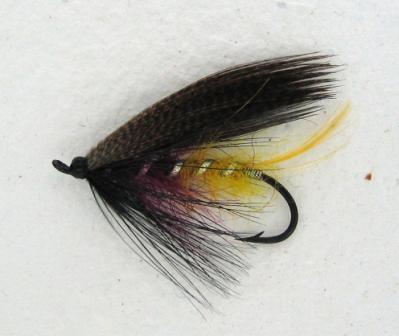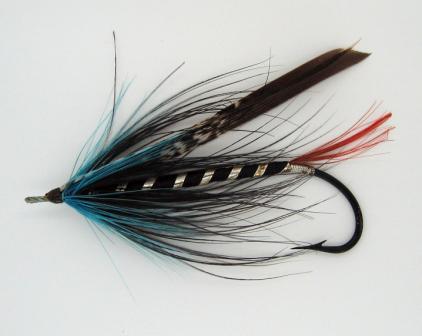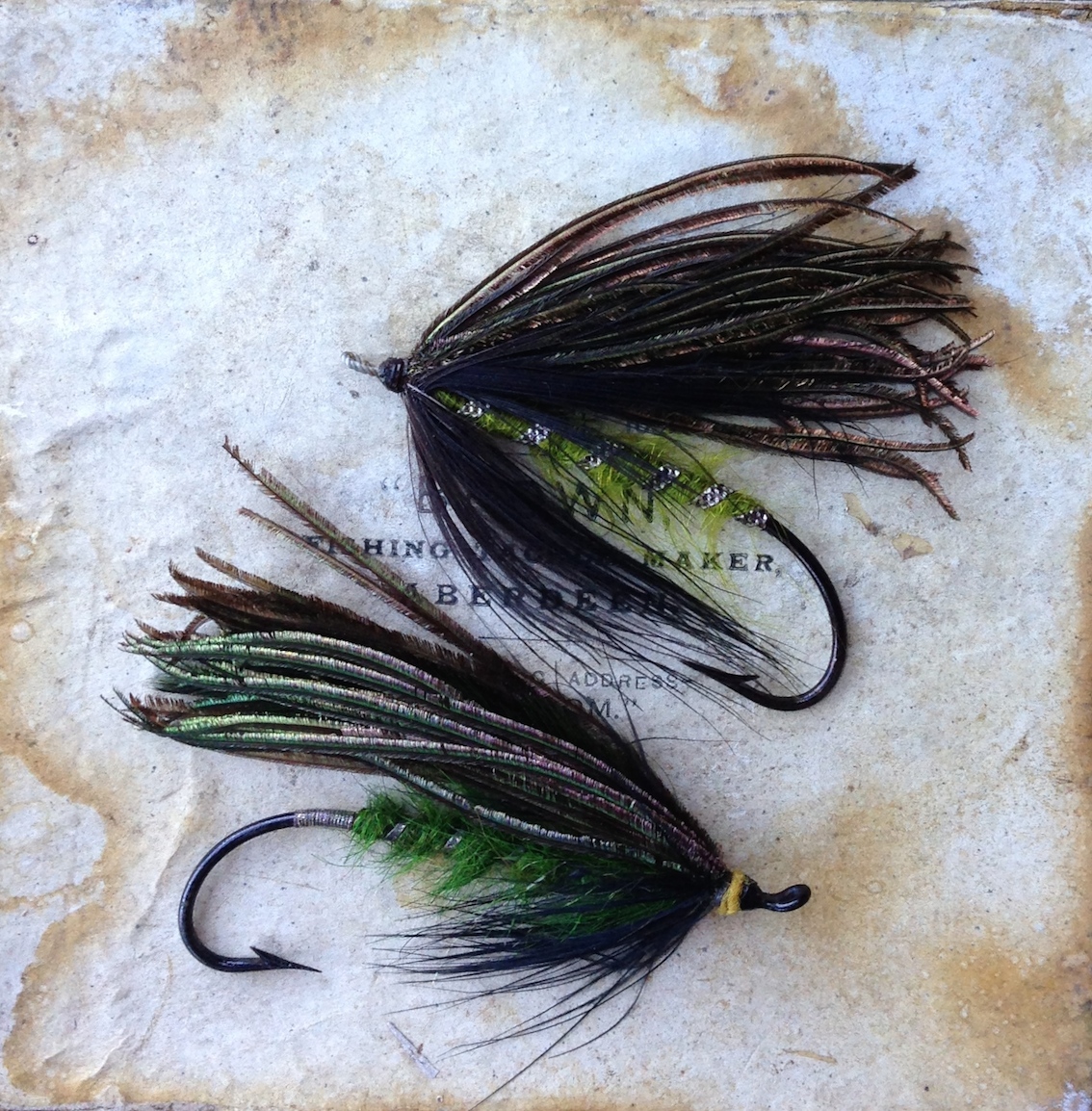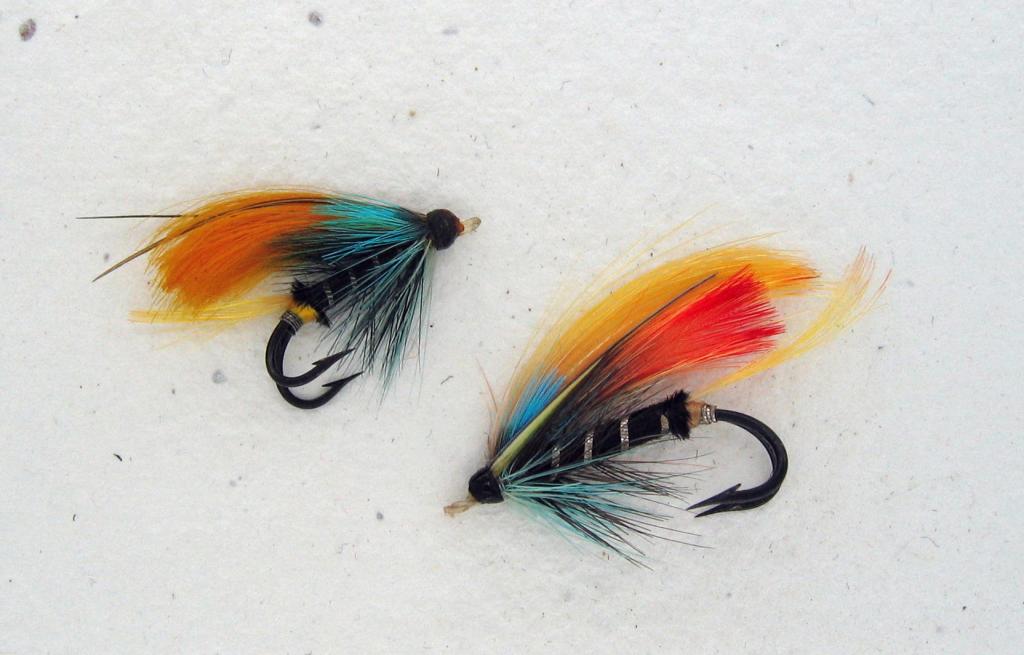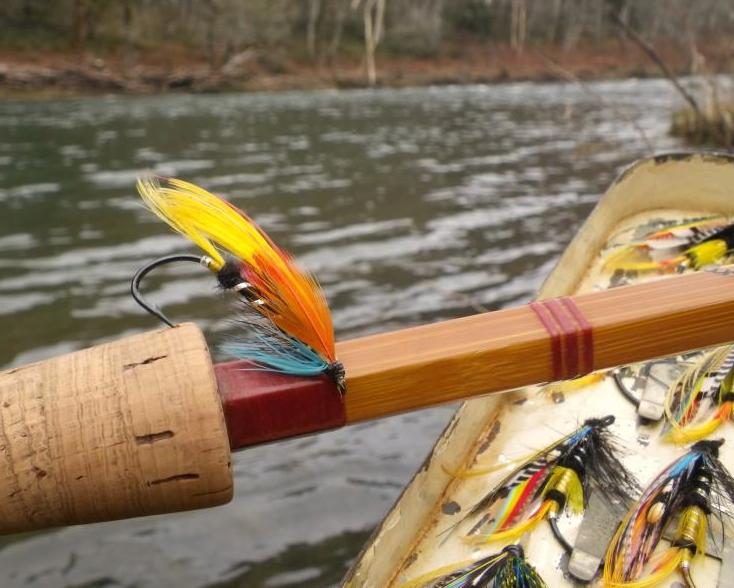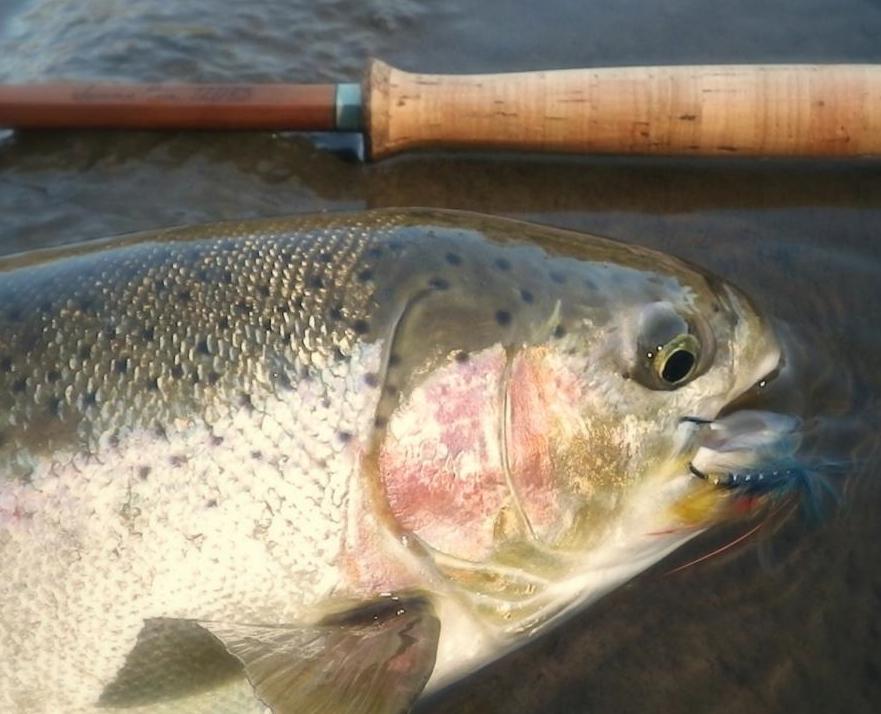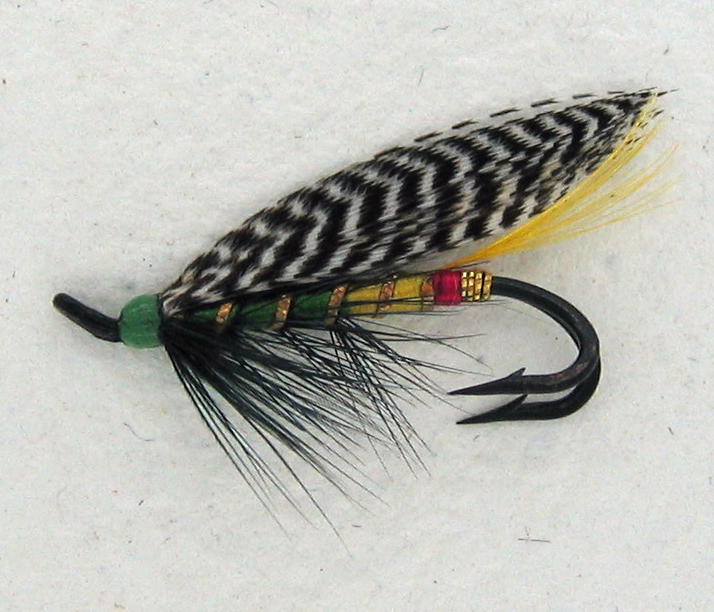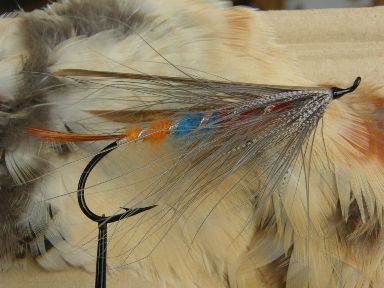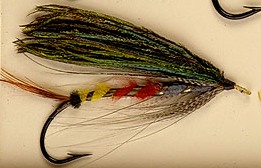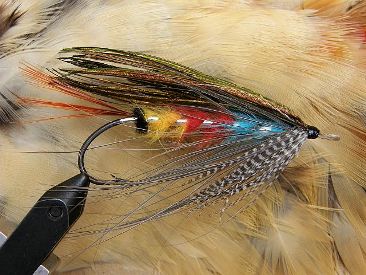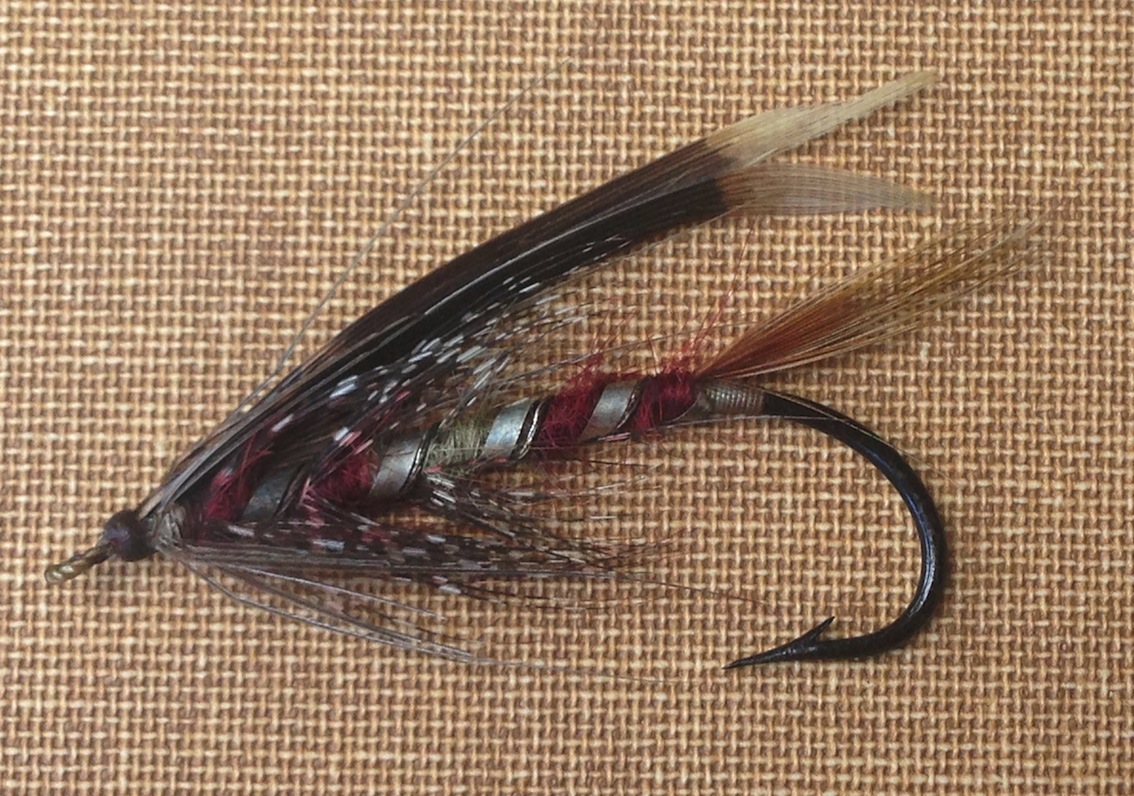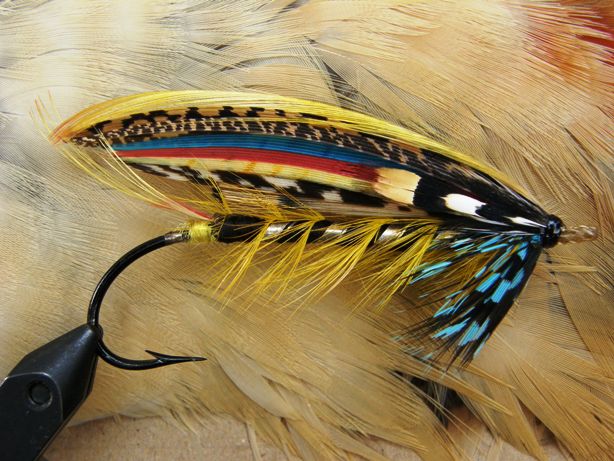 |
 |
|
Flies on this page Corniehaugh, Dark Bumble, Davie Caird, Dee Snow Fly, Dee Sun Fly, Deavan, Dodger, Dr Corbet (or Minister of Drumoak), Dr Forbes, Druggist. Please scroll down. Corniehaugh Presumed to be named after the Deveron beat of Corniehaugh and Mains of Mayen, seven miles down river from Huntly near the Tail: Golden pheasant tippet. Body: Flat silver tinsel. Ribs: Gold. Hackle: Black Wings: Cinnamon. Cheeks: Red
Dark Bumble
Tied for fishing by Guy Heard WM Tag; Silver thread Tail: Small topping Body: Yellow and claret mohair, well picked out; the claret to preponderate slightly and be nearest to head. Ribbed: Silver flatworm, 5 turns Wings: Double strips of very dark mallard Hackle: Black, only at shoulder, longish likewise and spare. Head: Black This hook we prefer single – Limericks, 4, 5, and 6, suitable for grilse and salmon. The Dark Bumble is the production of Mr Frank Farquharson, head keeper, Blackhall castle, than whom few can tie a neater fly.
Davie Caird
Superb vintage example Dee Snow Fly
A couple of vintage examples - I have been given the pattern for the Dee Snow Fly but it does not include the wing - however as Snow Flies always seem to have a herl wing, I am convinced that the flies above are correct. Dee Sun Fly
Vintage, note different wing materials
Tied by Aaron Ostoj, who gave it to Adrian Cortes
Who caught this with it! WM Tag: Silver thread, and bright yellow floss. Tail: Small topping, and two short sprigs of Indian crow. Butt: Black herl Body: Black silk floss, thinly laid on. Ribbing: Tinsel: Silver; very narrow; 5 turns in spiral form. Wings: Two or three Indian crow feathers to size of iron, and a couple of toppings. Feelers: Blue macaw on either side of wing. Hackle: Sparse black hackle from turn of tinsel nearest to tag; greenish-blue hackle sparely round shoulder. Head: Black. Range of irons, 5, 6, 7, and 8. Principally a grilse pattern. When the day is scorchingly bright, and fish on the take at all, a proper-sized specimen of this pattern is almost certain to ensure a capture in any fishable size of water. WM describes this fly as “one of our own patterns”. Deavan
Tied to fish with by Guy Heard WM Tag: Gold thread and magenta floss. Tail: A small topping. Butt: Bronze herl. Body: Yellow and bright green silk floss; one third (that nearest tag) yellow, the rest green. Ribbed: Gold twist, five turns. Wings: Double strips of teal, topping over. Hackle: Cock, black, half-way down the body. Head: Green herl. Double Limericks, 7, 8, and 9 are the best size. This fly is a great favourite with many excellent
Dodger The first two dressing of the Dodger describe a normal Dee style fly, the third dressing is of a Snow fly type
WM Tag: Silver Tinsel. Tail: Golden pheasant rump feather. Body: One turn orange, 2 turns greenish blue, and 3 turns clarety-red mohair all fairly picked out. Ribbed: Silver tinsel, 5 turns. Wings: In strips, ginger speckled turkey, lightish toward the tips. Hackle: Grey heron, very spare, and only a little way down the body. Shoulder: Teal round about – a small quantity. Head: Black Nos. 3, 4, 5, and 6. A good general pattern. WM Tag: Silver thread. Tail: Red saddle feather of golden pheasant. Body: Ribbed: Medium flat silver tinsel and silver twist, six turns. Hackle: Same quantity of long-fibred grey heron as on “Peacock,” and to extend over the scarlet and blue mohair. Shoulder: Teal, sparingly. Wings: Ginger spreckled turkey strips, lightish towards the tips. Mr. George Smith, Tackle Merchant, Ballater, has a splendid stock of these patterns, most of which are proved killer on all reaches above, and a good many reached below, that place. William Murdoch
Tag: Silver tinsel. Tail: Red rump feather golden pheasant. Butt: Black ostrich. Body: Light orange, scarlet, and medium blue mohair - three equal divisions; the scarlet and medium blue fairly well picked out. Ribbed: Flat silver tinsel. Hackle: Grey Heron of longish fibber, over the medium blue mohair. Shoulder: Teal. Wing: Bronze herl. Head: Varnished. The “Dodger,” the subject of our illustration on this occasion, being a snow-water fly of superior merit, is in our opinion that the present is just the proper time to bring it under notice of our readers. Often when a great deal of “snaw bree” is coming down, and the rivers run pretty high and clear, or, for that matter, when they are low and fringed with ice at the margin - and off and on this is pretty much the sate of matters at present - the best anglers fail to turn even a single scale in catches ever so well stocked with fish newly ascended from the sea. On occasions of this kind we have frequently seen first-rate anglers rummaging through their fly books in the hope of finding “a killer,” and pitching at last upon one “shoor to raise ‘im,” get straight to the pool and fish it with the greatest care, only, however, to find their favourite quite as useless as any other fly in their collection. We do not hint, much less venture to assert, that the Dodger would have killed; but we say with confidence that under conditions of the kind a deadlier fly cannot be mounted by anglers fishing on rivers north of the Patterns of Dodger and Akroyd from Mr. Wm. Garden, fishing tackle maker,
22nd October 1887, Aberdeenshire Rivers, Fishing Gazette, William Murdoch
The Dodger is a desperate killer when there is much snow-water in the river
Dr Corbet
Finally tracked down an original vintage one - so you can see how different my version is from the true version - lesson learnt ! MW Tag: Silver tinsel Tail: Golden pheasant saddle feather Body: First half claret and green, second half claret. Ribbing: Silver tinsel and gold twist. Hackle: grey heron; guinea fowl hackle down body. Wing: Brown mottled wing with black tips. Head: Black. “Dr. Corbet,” or the “Minister of Drumoak,” a favourite of long standing, is often used with good success in a moderate sized water during the spring season.
Dr. Forbes
Tag: Flat gold tinsel Tail: Golden pheasant crest and tippets Butt: Black ostrich Body: Rear half, bright orange silk, front, black silk Rib: Gold and silver tinsel Hackle: Black heron over black silk Throat: Golden pheasant red body hackle Wing: Dark mottled turkey.
Druggist
Hardy – Salmon Fishing, 1907 Tag: Silver tinsel; yellow floss. Tail: Topping. Body: Black Floss. Ribs: Silver tinsel. Hackle: Golden yellow. Throat: Jay. Wings: Tippet in centre; yellow, red and blue swan; bustard; peacock wing; golden pheasant tail; topping. Cheeks: Jungle cock. Head: Black.
|
